In this spotlight, Pure Earth’s Country Director for Bangladesh, Dr. Mahfuzar Rahman, and Pure Earth Bangladesh Communications Lead, Mitali Das, share updates about the team’s efforts to mitigate lead pollution in Bangladesh.
Follow and stay updated on Pure Earth Bangladesh @PureEarthBD on Facebook, Twitter, and YouTube.
By working together with partners, Pure Earth Bangladesh has made significant progress addressing the lead pollution issue on national and global platforms. Our strong commitments and five-phase strategic approach towards building a ‘lead safe’ Bangladesh have brought meaningful, measurable, and sustainable results in protecting children from lead exposure and our efforts will continue to move forward in 2023. We would like to take this moment to look back and share some of our achievements, and updates on new developments to come.

Testing Children’s Blood Lead Levels
Pure Earth Bangladesh is working collaboratively with Stanford University and the International Centre for Diarrhoeal Disease Research, Bangladesh (icddr,b) to collect blood samples for blood lead level (BLL) analysis from a total of 1398 children and pregnant women (500 pregnant women and 898 children) living in four northern rural districts of Bangladesh: Mymensingh, Kishoreganj, Tangail, and Gazipur as well as in Munshiganj, an area close to Dhaka city. 25% of the total blood samples (total 350 samples; 225 children’s blood sample, and 125 pregnant women’s blood sample) will be tested using the Graphite furnace atomic absorption spectrometry (GFAAS).
A baseline BLL analysis has been conducted among 200 children in Mirzapur, the community in which Pure Earth conducted remediation efforts. The highest BLL found was 47 ug/dL. These BLL results will help us measure the impact of our intervention and increase the justification for, and the likelihood of, replication of such interventions to protect children.
The BLL data we are collecting will help support the Bangladesh’s Directorate General of Health Services (DGHS) in developing a national-level surveillance to monitor BLL of children throughout the country. We are also working on getting BLL testing included in the country’s National Health and Nutrition surveys.
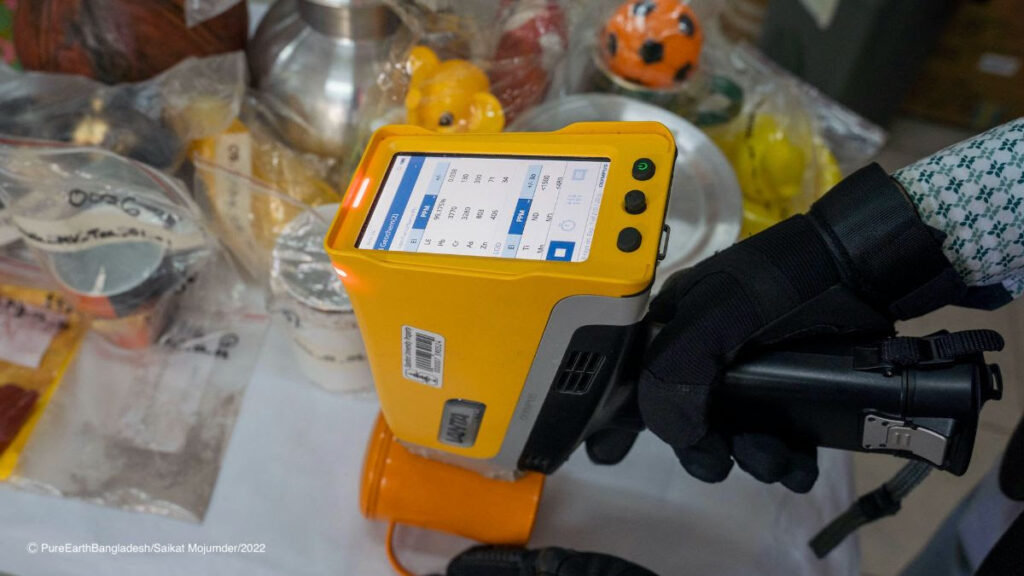
Analyzing Potential Sources of Lead Pollution
As of 2020, Pure Earth Bangladesh, together with the Department of Geology, University of Dhaka, has identified more than 300 toxic sites, under the Toxic Site Identification Program (TSIP), where informal recycling of used lead-acid batteries (ULAB) have been found as one of the major sources of lead pollution. In 2022, Pure Earth shortlisted 30 toxic sites for further investigation. 24 sites were assessed by the TSIP program and initial site assessments (ISA) were conducted in six high-endemic lead poisoning areas to determine future lead remediation efforts.
Continuing the search for potential sources, Rapid Market Screenings (RMS) were conducted with funding from GiveWell during the period of 2021-2022. The RMS took place in four major districts: Dhaka, Rajshahi, Khulna, and Barishal. Pure Earth investigators visited markets, collected data and samples as ascertained from a desk review report, and tested the samples with an XRF (X-ray fluorescence) analyzer. Some of the samples like vegetables, rice, and aluminum cookware went through a leaching test in the laboratory. The preliminary findings show that 96 samples are lead-positive among 367 samples, with the major sources being aluminum cookware, ceramic foodware, local paints, toys, amulets, pigments, and other non-food items.
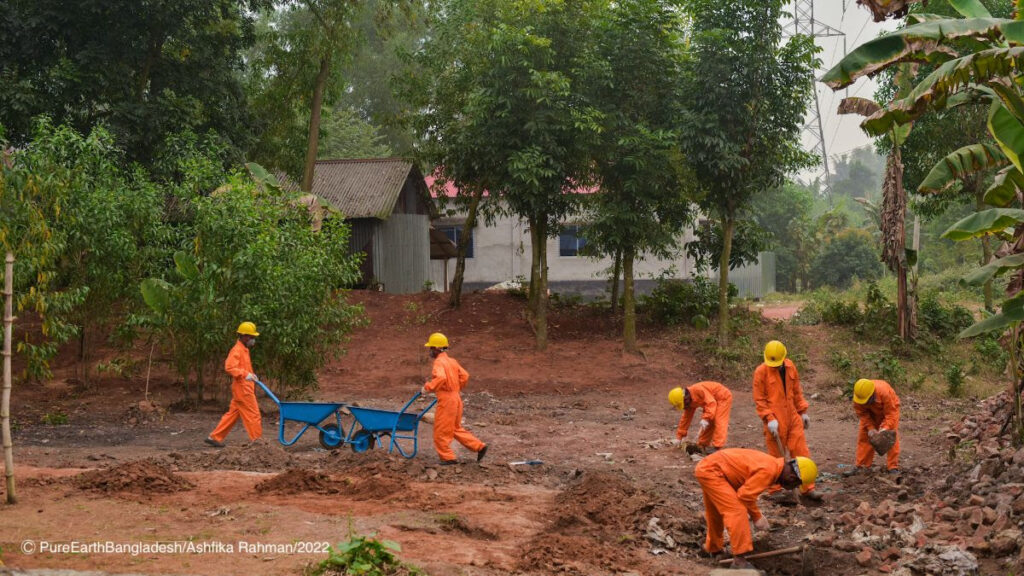
Risk Reduction Interventions
The first known lead remediation in Bangladesh was conducted in Kathgora, Savar, in 2017. This resulted in a 35% decline in children’s blood lead levels. In May 2022, Pure Earth conducted a second remediation project in Mirzapur, Tangail, with the support from Department of Geology, University of Dhaka, under the supervision of the Department of Environment (DoE), with funding from the TAUW Foundation, Clarios Foundation, and USAID.
The risk-mitigation strategy for Mirzapur included pre- and post-project environmental and BLL sampling and analysis; an education, awareness, and advocacy campaign; collection, packaging, transportation, and disposal of residual battery wastes; scraping, and stockpiling of lead-impacted soil and leaf matter; pit excavation, phosphate amendment and burial of lead impacted soil; house cleaning; and yard remediation.
This remediation project has ensured a lead-free, safe environment for more than 600 villagers. With support from icddr,b, 200 children were tested for lead, and environmental samples were collected and analyzed to further understand the contributing sources of lead pollution.
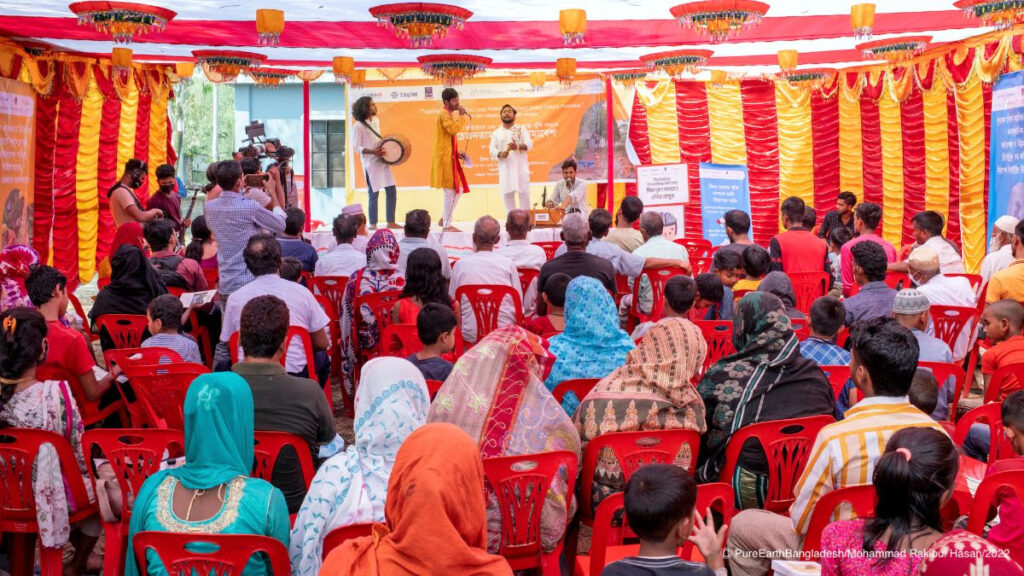
Raising Awareness and Advocating for Solving Lead Pollution
Our online and offline campaign and advocacy strategy has successfully mobilized about 50 million people including community members, youth, and various stakeholders to take unified action to solve lead pollution. Pure Earth’s lead work was covered in more than 250 local and international print and electronic media.
Public events include national and district-level seminars, an awareness raising rally, film screening, art competitions with youth groups, media engagements during International Lead Poisoning Prevention Week (ILPPW) 2022, a seminar during World Environment Day, and social media and print media campaigns. These have helped to secure a strong commitment from our stakeholders to prioritize and work together to protect the environment and human health from lead poisoning. In addition, courtyard and school sessions with youth groups, meetings with health workers, and community gathering events have sensitized community members, youth, and health workers, and reduced the risk of lead exposure.
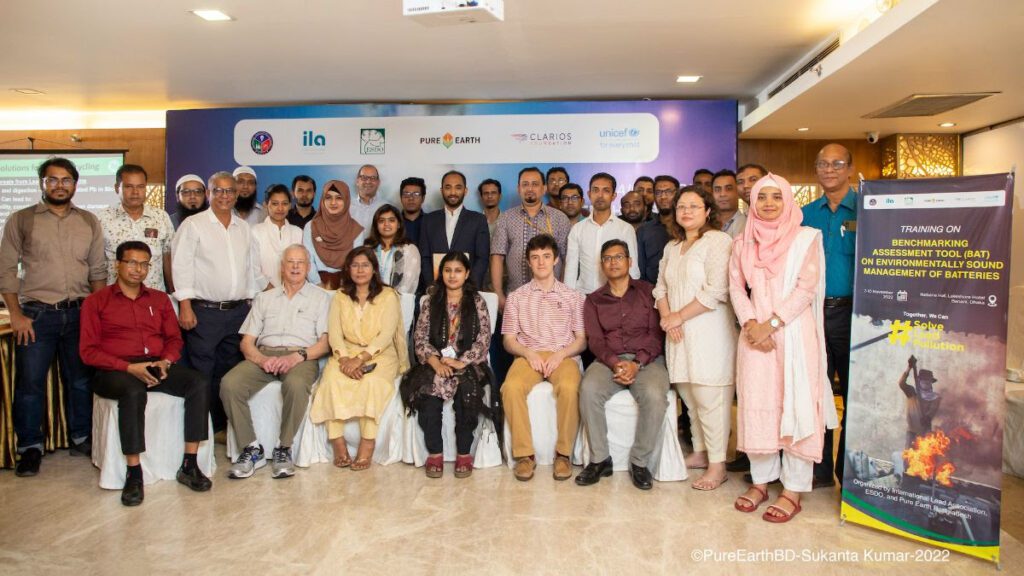
Partnering on Sustainable Solutions
Our work addressing lead in Bangladesh has been strengthened by forming a coalition with more than 10 organizations and institutions including UNICEF, International Lead Association (ILA), UNEP, Dhaka University, ESDO, icddr,b, and Stamford University. Pure Earth Bangladesh’s multi-stakeholder approach seeks to work collaboratively with local and national governments, NGOs, civil society organizations, research institutes, universities, and media agencies to reduce lead exposure, raise awareness, and design and implement innovative solutions to save lives. Together with UNICEF and Bangladesh’s Directorate General of Health Services (DGHS), Pure Earth Bangladesh is working closely on the National Guidelines for Case Management, Monitoring, and Surveillance System. We are also providing training on the Benchmarking Assessment tools (BAT) to help to build capacity to enable the Department of Environment (DoE), battery companies, and NGOs to ensure environmentally sound management of lead.
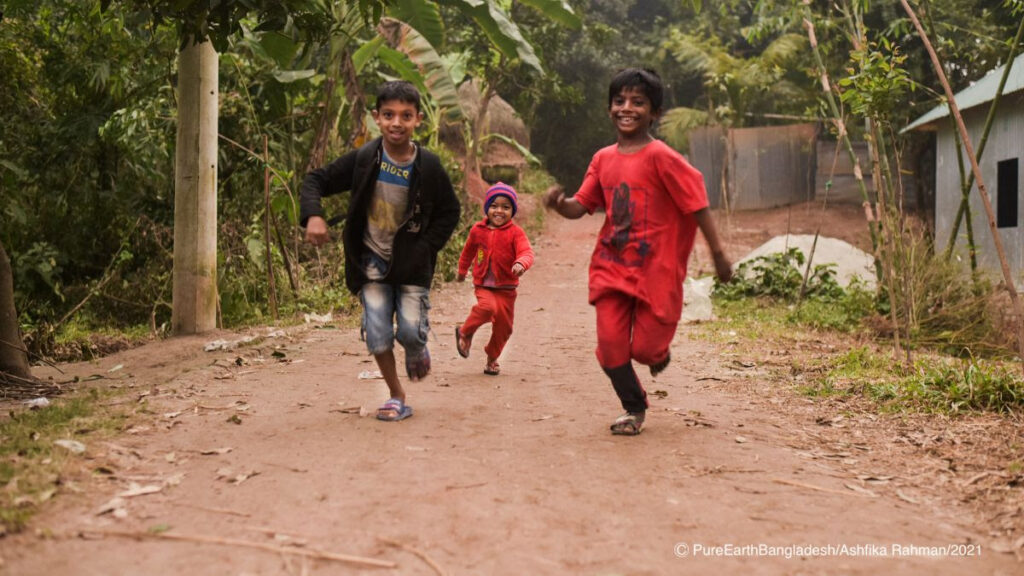
Moving Forward
Pure Earth Bangladesh will continue to protect children from lead poisoning by engaging multi-stakeholders and working collaboratively with local partners to raise awareness and advocate for the implementation of legislation, and to set and enforce standards that properly regulate the safe manufacture, use, and most importantly, smelting of lead-acid batteries.
In 2023, Pure Earth Bangladesh will conduct two remediation projects, an analysis of 200 children in Mirzapur, and awareness and education programs in the community and schools at the priority sites.
Pure Earth Bangladesh will share results of BLL, source analyses, case studies, and relevant guidance with local, national, and international stakeholders to roll out public/consumer education and producer training programs, sensitize governments to potential intervention strategies and develop joint action plans, and to provide technical assistance (training, communications, joint investigations) to governments to enforce regulations.
We will share more updates in our annual newsletter and on our social media channels. Please follow us and stay updated at @PureEarthBD on Facebook, Twitter, and YouTube.



